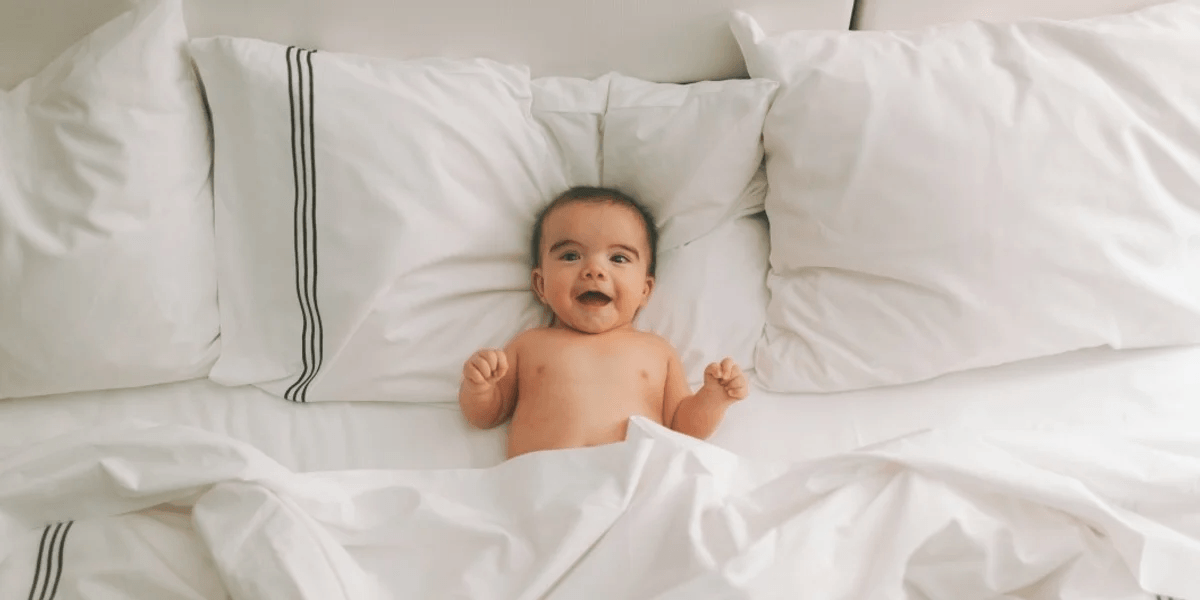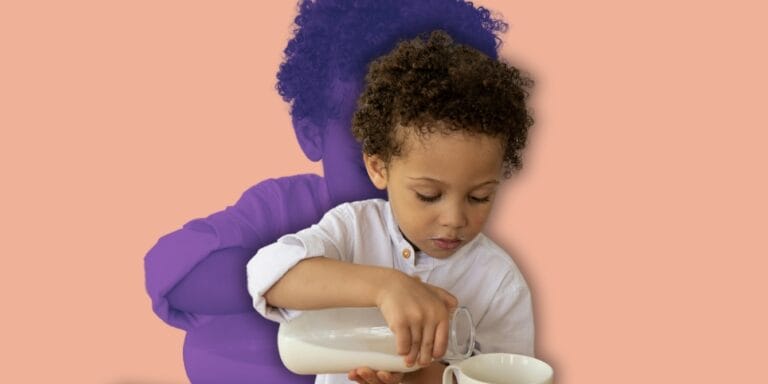One mama’s scientific case for co-sleeping

Mothers have slept alongside their babies since the beginning of time. In many countries, it’s still the norm. Here’s why.
Table of Contents
Editor’s note: This essay describes a parent’s experience with and research into bed sharing. To learn more about the American Academy of Pediatrics safe sleep recommendations please visit the AAP.
Like many parents, we began co-sleeping by necessity. Most women find that they bring the baby into the bed to nurse, and keep falling asleep; it’s easier and safer to plan for bed-sharing than for it to happen inadvertently. We were a little different, however.
Because of reflux and other health problems, my son had trouble gaining weight. A different pediatrician probably would have called it “failure to thrive.” We wanted him to nurse often at night, and sleeping next to me seemed a good way to do that.
It worked. Sleep reserchers Mosko, Richard, and McKenna proved that arousals are greater between bed-sharing pairs, meaning that these co-sleeping mothers and babies half-wake more often than mothers and babies who sleep apart. My son and I used these arousals to latch him to the breast more often. As time went on, he learned to latch himself; this is common among bed-sharing pairs.
In fact, James McKenna of the Notre Dame Mother-Baby Sleep Laboratory argues that frequent arousals are good for babies, because they promote what’s really important in the first year of a baby’s life: breastfeeding.
This isn’t to bash formula feeding. Far from it. But Dr. McKenna, like Dr. Bill Sears, argues that breastmilk is best for babies. And when you talk about safe co-sleeping, you talk about breastfeeding.
Co-sleeping promotes breastfeeding
Dr. McKenna claims that babies will “breastfeed more often, with less disruption to mother’s sleep” when bed-sharing. This, he says, “can also be translated into less disease and morbidity.” Basically, the more babies breastfeed, the more likely they are to reap the benefits of breastfeeding, which include, according to a position paper of the journal Pediatrics, improved developmental outcomes, a decrease in the incidence and severity of numerous infectious diseases (including among middle-class populations of developed countries), a decrease in SIDS and lower risk of diabetes.
Of course, breastfeeding is a choice. But it’s a choice many mothers are making. In 2013, according to the CDC, 81.1% of American mothers began to breastfeed, and 60.6% were still breastfeeding at six months. In the US, only 12.8% of parents bed-share (though 45% of infants spent some time in an adult bed in the last two weeks).
That could account for the precipitous drop between breastfeeding initiated and breastfeeding continued at six months: no one wants to get up, go to a crib, pick up a baby, nurse her, put her back to sleep, and go back to bed every two hours, the normally cited time between breastfed baby feeds.
Formula, according to “Night Waking: Will I Ever Get a Good Night’s Sleep Again?” forms larger curds in the baby’s stomach. This means it take longer to digest, and hence formula-fed babies can go longer between feedings (the typical four-hour schedule) than their breastfed counterparts.
Basically, the closer you sleep to your baby, the easier it is to breastfeed. As Dr. McKenna says, “Proximity, of course, makes it more likely and possible that more interaction will take place between the mother and infants during the night, including more breastfeeding.” Mother and baby will move towards each other, even in sleep; babies—like my son—will learn to latch themselves. (This is partly why, according to breastfeeding website Kellymom, mother and baby both tend to get more sleep while co-sleeping). All this nursing helps maintain mother’s milk supply, especially if she works and is away from baby for significant amounts of time every day.
There’s even a name for this: reverse cycling. Basically, when baby is separated from mother all day, he makes up for it by nursing more at night than he eats during the day. This can be frustrating, since baby’s up nursing over, and over, and over, but lets baby get the nutrients he needs, and the mama time he craves.
Co-sleeping is biologically normal
As attachment expert Tami Breazeale says in “Co-Sleeping,” the practice of mothers and babies sleeping separately is both a recent and a Western one. Dr. McKenna notes in “Co-sleeping Around the World” that “for the overwhelming majority of mothers and babies around the globe today, co-sleeping is an unquestioned practice.”
This remains the case in much of Southern Europe, Asia, Africa, and Central and South America. Some cultures bed-share; others co-sleep with a bassinet or hammock in the room. Using CDC data from 1981, McKenna says that 68% of American babies co-sleep at some point, and 26% “always” or “almost always.”
Breazeale notes that co-sleeping is almost 100% in “classic studies which included more than 200 cultures… including the Japanese, the Korean, the Phillipino, the Eskimo Indian, the !Kung San of Africa, and the natives of Okinowa.” She also says that only 48% of kibuttzum children, who saw their parents for four hours a day and slept with age-mates, had a secure attachment to their mothers.
The human baby, McKenna says, depends on care from the mother. For the infant, co-sleeping represents “a form of expected physiological regulation and support.” Indeed, he says:
“Infants require this contact and proximity especially because of nutritional needs (breastfeeding) but also because of the immaturity of their thermo-regulatory, immune, and cardio-respiratory systems, in addition to their dependence on touch, all systems closely tied together to promote efficient functioning of all of the infant’s immature organs and the central nervous system in general.”
The infant breathing system, both voluntary and autonomic, is not fully matured at birth, and especially functions immaturely during sleep. The human infant’s physiology, McKenna says, “is not designed to function optimally outside the context by which usually the breastfeeding mother can compensate for the infants developmental (neurological) vulnerabilities.” Basically, babies are biologically hardwired to sleep next to a breastfeeding mother, with whom they can sync breathing, heart rate, and more.
Who gets more sleep?
According to Kellymom, generally the Internet go-to for breastfeeding information, co-sleeping parents get more sleep than parents who don’t share the same sleep surface. And who doesn’t want more sleep? Families who sleep together end up sharing the same sleep rhythms. Dr. Jay Gordon recounts James McKenna watching mother-father-baby trios at the Notre Dame sleep laboratory fall in and out of sleep at the same time: stirring and moving simultaneously.
Researchers at East Tennessee State University proved, with 33 first-time mother-baby dyads, that while breastfed babies got less total sleep, breastfeeding mothers got more over a 24-hour period. Both mother and baby remained in a lighter stage of sleep, enabling arousal to nurse, and acting as a protective buffer against adverse sleep events. The researchers have proven what mothers have known since the dawn of time: co-sleeping mamas get more sleep.
Is co-sleeping safe?
A 2014 study in the journal Pediatrics, claims that 69% of infants who died of SIDS were bed-sharing at the time. However, the study doesn’t account for the type of sleep surface; couches and recliners are perilously dangerous for sleeping infants. Nor did it evaluate each situation for a safe sleep environment. Were there heavy pillows and blankets around the infant? Was entrapment between mattress and wall an issue? The study doesn’t distinguish between responsible co-sleepers and parents inebriated with alcohol or drugs. Nor does it account for cigarette smoking in the home (a known SIDS risk factor). So while the study might immediately frighten bed-sharing parents, there are too many holes to make a determination of the data.
A British study did find that bed-sharing was still a SIDS risk when the parents didn’t smoke, drink, or use drugs. But again, the same problems exist with the study. Safe sleep environment and sleep location make a crucial difference when determining the safety of co-sleeping.
And co-sleeping is safe. McKenna and Gettler say because breastfeeding is a protective factor against SIDS, “safe bed-sharing may actually exert a protective effect against SIDS.” Mothers sleeping next to their babies, they argue, and breastfeeding, is “an evolved suite of behaviors tracing humans’ phylogentic roots as both primates and mammals.”
We evolved to breastfeed and co-sleep, and evolution wouldn’t favor a practice that led to the sudden and inexplicable death of infants. Dr. Sears agrees, and notes that countries with high co-sleeping rates have the lowest rates of SIDS. He also says that “infants who sleep near to parents have more stable temperatures, regular heart rhythms, and fewer long pauses in breathing compared to babies who sleep alone. This means baby sleeps physiologically safer.”
The American Academy of Pediatrics actually recommends co-sleeping, defined as the caregiver sleeping in the same room as the infant, albeit on a separate sleeping surface from the parent. This, they’ve found, reduces the risk of SIDS. They still recommend against bed-sharing, but, as McKenna and Gettler note, “epidemiological studies reveal inconsistent findings as to whether or not, to what degree, or under what circumstances bed-sharing represents a consistent risk factor for SIDS.”
What is a safe co-sleeping environment?
James McKenna details, on his website, what makes for a safe bed-sharing setup. First, the mattress must be dropped to the floor, making it only a few inches high. It also must be pulled away from the wall, to prevent movement and entrapment. Parents should dress warmly, to use as few covers as possible, and the covers they use should be light and airy, not heavy comforters. One pillow is allotted per person, and the bed must remain free of toys, stuffed animals, etc. He recommends that other children and pets remain out of the bed, and that siblings certainly never sleep next to the baby.
When our new baby came home from the hospital, we had already dropped our mattress and pulled it away from the wall. We had a queen-sized mattress with a twin-sized sidecar, because we knew how many people were getting in there. Each person was allotted one pillow. My husband slept on the single bed, and in the middle of the night, our older sons, then two and four, crept in to cuddle with him. I slept on the far side of the queen bed with the baby cradled on my arm. We slept with light covers up to our waists.
You’ll find as many co-sleeping environments as you find families. However, by and large, planned bed-sharers—as opposed to those who bed-share accidentally, say by falling asleep while nursing—follow the rules. They may sneak in an extra pillow, or let their dog in bed, but they mostly adhere to the common sense guidelines laid out by Dr. McKenna.
Is co-sleeping right for you?
Most importantly, co-sleeping is safe. But it also affords more sleep for a breastfeeding mother, remains the biological norm in many parts of the world, and actually encourages nursing—a protective effect against SIDS. While Dr. McKenna recommends against bottle-feeding mothers bed-sharing, since they don’t seem to share the same biological rhythms as their babies, for nursing mothers, co-sleeping seems the best choice.
As long as the family maintains a safe sleep environment, families should be empowered to make their own decisions. If mama and daddy are both in agreement, co-sleeping is probably the best choice for their family. And that’s something we can all sleep on.
[This post was originally published October 14, 2016.]


































